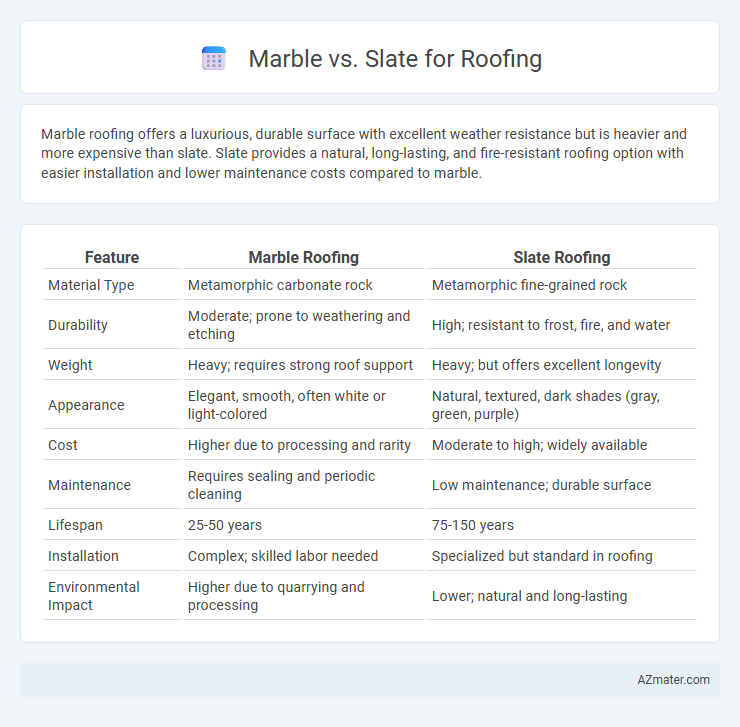Marble roofing offers a luxurious, durable surface with excellent weather resistance but is heavier and more expensive than slate. Slate provides a natural, long-lasting, and fire-resistant roofing option with easier installation and lower maintenance costs compared to marble.
Table of Comparison
| Feature | Marble Roofing | Slate Roofing |
|---|---|---|
| Material Type | Metamorphic carbonate rock | Metamorphic fine-grained rock |
| Durability | Moderate; prone to weathering and etching | High; resistant to frost, fire, and water |
| Weight | Heavy; requires strong roof support | Heavy; but offers excellent longevity |
| Appearance | Elegant, smooth, often white or light-colored | Natural, textured, dark shades (gray, green, purple) |
| Cost | Higher due to processing and rarity | Moderate to high; widely available |
| Maintenance | Requires sealing and periodic cleaning | Low maintenance; durable surface |
| Lifespan | 25-50 years | 75-150 years |
| Installation | Complex; skilled labor needed | Specialized but standard in roofing |
| Environmental Impact | Higher due to quarrying and processing | Lower; natural and long-lasting |
Introduction to Marble and Slate Roofing
Marble roofing offers exceptional durability and a luxurious appearance characterized by its natural veining and smooth texture, making it a premium choice for elegant architectural designs. Slate roofing is renowned for its longevity, resistance to weather elements, and distinctive layered texture, providing a classic and timeless aesthetic. Both materials are natural stones, presenting eco-friendly roofing options with unique visual and structural benefits.
Historical Use of Marble and Slate in Roofing
Marble and slate have been used in roofing for centuries, with slate favored since Roman times for its durability and natural cleavage, allowing it to be split into thin, uniform tiles that provide excellent weather resistance. Marble, valued for its aesthetic appeal and sourced from regions like Italy and Greece, was historically employed in roofing mainly in monumental architecture, where its unique veining and polished finish contributed to ornate, prestigious buildings. The enduring legacy of slate roofing in medieval Europe contrasts with marble's selective application, highlighting the materials' differing roles influenced by regional availability and architectural priorities.
Physical Properties Comparison
Marble exhibits a higher density and hardness, making it more resistant to scratching and weathering compared to slate, which is known for its excellent durability and natural cleft surface that provides superior slip resistance. Slate has a lower water absorption rate, typically less than 0.4%, enhancing its resistance to freeze-thaw cycles, whereas marble's porosity can lead to higher susceptibility to moisture-related damage. Both materials offer strong compressive strength, but slate's layered structure allows for easier splitting into thin, uniform roofing tiles, making it a preferred choice for roofing applications where flexibility and weight are critical factors.
Durability and Longevity
Marble roofing offers impressive durability with a lifespan of up to 50 years, maintaining its aesthetic appeal despite exposure to weather elements. Slate roofing surpasses marble by providing exceptional longevity, often lasting over 100 years due to its natural resistance to cracking, chipping, and water absorption. Both materials deliver superior performance, but slate's durability makes it a top choice for long-term roofing solutions.
Aesthetic Appeal and Design Versatility
Marble roofing offers a luxurious, polished appearance with unique veining patterns that create a sophisticated aesthetic ideal for high-end architectural designs. Slate roofing provides a natural, textured look with a range of earthy tones, delivering timeless elegance and exceptional design versatility suited for both traditional and modern homes. Both materials enhance curb appeal, but marble's glossy finish contrasts with slate's matte surface, influencing the overall visual impact and style adaptability.
Installation Process and Requirements
Marble roofing requires skilled installers due to its heavy weight and unique cutting needs, demanding reinforced roof structures and precise fitting to prevent cracking. Slate roofing, known for its durability and lighter weight compared to marble, involves careful nailing techniques and usually requires underlayment to enhance weather resistance. Both materials need experienced professionals to ensure proper alignment, secure fastening, and adequate support, but slate typically offers more straightforward installation with standard roofing components.
Maintenance Needs and Challenges
Marble roofing requires regular sealing and cleaning to prevent staining and weathering, making maintenance more intensive than slate. Slate offers superior durability with minimal upkeep, as it naturally resists moisture, mold, and insects, reducing long-term maintenance challenges. Both materials demand skilled installation to avoid damage, but slate's longevity and resilience often result in lower overall maintenance costs.
Cost Analysis: Marble vs Slate Roofing
Marble roofing costs significantly more than slate due to its higher material price and complex installation requirements, often ranging from $30 to $50 per square foot compared to slate's $15 to $30 per square foot. Slate offers a more cost-effective option with exceptional durability and lower maintenance expenses over time, making it a preferred choice for budget-conscious projects seeking long-term value. Marble's premium aesthetic justifies its higher price in luxury settings, but slate remains the optimal balance between cost, lifespan, and performance for most roofing applications.
Environmental Impact and Sustainability
Marble roofing involves energy-intensive quarrying and processing, leading to higher carbon emissions compared to slate, which is naturally split into thin, durable sheets with minimal processing. Slate offers superior longevity and recyclability, reducing landfill waste and the need for frequent roof replacements. Choosing slate over marble supports sustainable construction by minimizing environmental degradation and promoting resource efficiency.
Choosing the Right Material for Your Roof
Marble roofing offers durability and a unique aesthetic with its natural veining and color variations, making it ideal for luxury homes in temperate climates. Slate roofing is highly resistant to weather extremes and provides excellent fire resistance, longevity up to 100 years, and minimal maintenance, suitable for historic or high-end constructions. Selecting between marble and slate depends on factors such as climate, budget, desired aesthetic, and the structural capacity of the roof to support heavier stone materials.

Infographic: Marble vs Slate for Roofing
 azmater.com
azmater.com